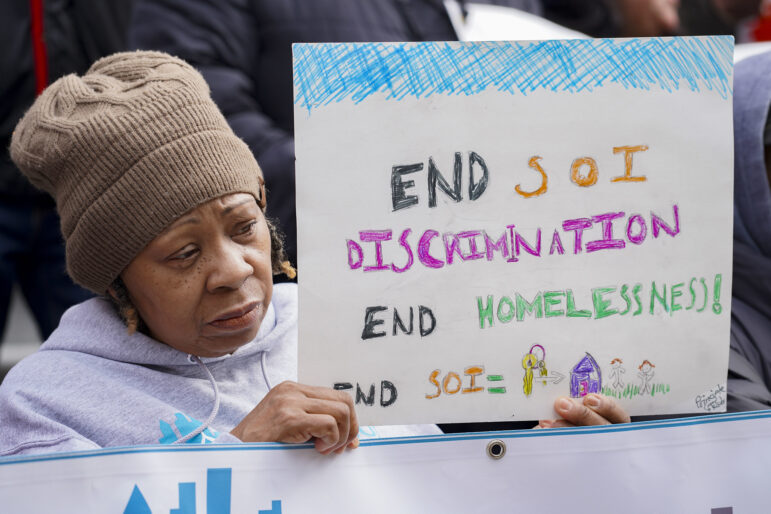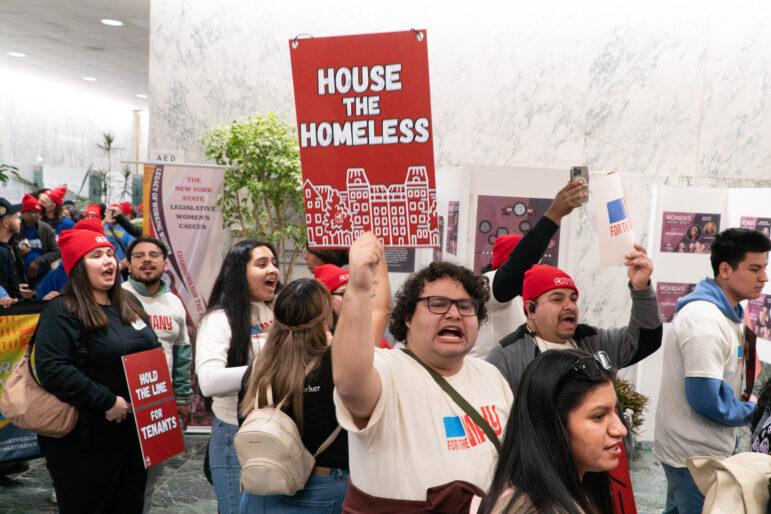A woman in a white puffy coat and her lawyer sit at a blond-wood conference table on the left side of the courtroom. On the right, a lawyer for the city and a caseworker from the city’s child protective agency fill a twin conference table. A lawyer for the child who is the focus of the hearing sits at a small side table, barricaded by stacks of folders and binders. The judge sits at the center of a low, wood-paneled dais. Her court attorney, two clerical workers, and a pair of armed, uniformed court clerks populate the front of the courtroom, under the “In God We Trust” emblazoned in brushed-metal capital letters on the wall, as the court reporter quietly taps out the record. The woman is in court to formally terminate her parental rights—to “free” her 8-year-old son, who has spent most of his life in the foster care of another woman, for adoption.
Papers are shuffled and submitted to the judge for scrutiny. Lawyers stand up and sit down again. The mother is asked if she understands everything that is happening in the court: “This surrender document is final and irrevocable. You can never take it back,” the judge says, slowly and clearly. The woman says she understands. Another woman, rising from her bench in the small gallery section, is the child’s foster mother, with whom he’s lived for six of his eight years. She says she wants to adopt the child; she says he calls her Mommy.
The woman in the puffy coat keeps her eyes fixed forward. (The child’s father came inebriated to one earlier court session and has not returned for this proceeding, which will, in absentia, end his legal fatherhood.)
Seven minutes after the hearing is called to order and the participants sworn to tell the truth, the matter is concluded: The boy is freed—no longer the child of his biological mother—and will be adopted by the foster mother, who wants him. The child himself is absent from the courtroom and, quite possibly, silent in the case. It is not clear whether the judge spoke with him at all. His young age means that his consent was not required. The boy’s biological mom zips her coat and strides out of the courtroom, boot heels clicking on the tan linoleum tile: No tears, or none visible. The lawyers gather their papers and belongings. The clerk calls, “Next case.”
Blood ties broken, new ties forged, in under 10 minutes. Next case.
A quiet crisis
Every day in New York City, mothers and fathers stand up in Family Court to hear a judge say they must sever all ties to their biological child. In courtrooms from the Grand Concourse in the Bronx to Richmond Terrace in Staten Island, other parents face charges of child abuse and neglect, their children removed to foster care—a return home uncertain, sometimes impossible. Meanwhile, hundreds thrash out custody arrangements and child support deals; some argue over paternity or beg the court to take charge of their wayward child. Others simply wait. They wait to see children detained in juvenile justice proceedings, who are held out of view and escorted to proceedings in handcuffs. They wait for court clerks to help them swear out orders of protection against abusive or violent spouses (or children). They wait for judges and lawyers to meet and render judgment.
Children are at the heart of every proceeding every day in every Family Court chamber in New York City, whether as defendants awaiting juvenile justice proceedings or children needing adult care or, most often, victims of the abuse and neglect that sunders thousands of city families each year. The lives of the city’s most vulnerable citizens—tens of thousands of its neediest children—are irrevocably shaped by the decisions handed down in Family Court, yet the children themselves are rarely present and are almost always silent.
Absent along with the children is the attention of most of New York City to the human drama that plays out, over vast expanses of time and at taxpayer expense, in the halls and chambers of each borough’s Family Court.
Every few years, a young life somewhere in New York is extinguished or scarred by abuse so horrifying that the tabloid ink flows in rivers. Politicians call for reform. Bills are proposed and speeches made. Then, inexorably, the outrage fades. Family Court, however, grinds on.
Today, those twin aspects of Family Court—its obscurity and its inertia—coupled with profoundly crippling economic pressure, make the situation playing out there increasingly precarious.
Systemic stress
Over three months of observing Family Court around the city and speaking to scores of the lawyers, judges, parents and advocates who populate it, City Limits learned that an already near impossible task has, in recent years, become even harder to perform.
Judges are severely overburdened, but judicial seats go unfilled. Family Court dockets “exceed the capacity of a limited corps of judges and staff,” according to a 2008 report by the New York State Senate’s Judiciary Committee. Loaner judges serve on the Family Court bench with mixed enthusiasm—and with steep learning curves. Delays between hearings can stretch for a month or more, as judges and lawyers juggle dockets and obligations in other courts. Child abuse, neglect, custody and support cases can take years to complete.
Recent budget cuts have gutted programs that lightened some of the judges’ burden. The same cuts have also eliminated procedural structures designed to expedite cases and to help rebuild or restore families to relative health. Meanwhile, the number of dockets and dispositions is rising. In Family Court, otherwise positive social changes, like legal recognition of same-sex couples, merely add to the volume.
“Everyone says, ‘We care about children. Children are our top priority,’ ” the top Family Court official, Administrative Judge Edwina Richardson-Mendelson, told City Limits in an interview. “But if the resources aren’t there to provide services, what do you do?”
Yet money is not the root of all Family Court’s problems. Backlogs arise from a voluminous flow of paper proceedings. Different Family Court jurists hear each strand of a single family’s case, but the judges don’t communicate directly about cases they share. Parents use the court’s bureaucratic maze as a cover for personal legal warfare. Lawyers, hard-pressed to serve myriad clients, cause delays—whether inadvertently or deliberately as a tactic—while children age in limbo. Services for strained families disappear amid fiscal austerity.
Nascent efforts at juvenile justice reform—like Gov. Andrew Cuomo’s recent approval of Mayor Michael Bloomberg’s bid to keep New York City children closer to home when they’re sent by a juvenile court to a detention facility—strive to untangle part of the Gordian knot, and some seem to be paying dividends.
But 96 percent of Family Court cases involve children in abuse, custody, or child support or visitation cases, not juvenile justice proceedings— and there is substantial evidence those children are facing a more difficult path through Family Court. The wait for adoption is increasing; New York ranks 50th among the states in time required for permanent adoption. Despite forceful pressures on the city’s child welfare agency (the Administration for Children’s Services) and judges to resolve cases quickly, the city’s children are staying in foster care longer.
Complexity stymies reform
All this exists beyond public attention, which tends to arrive only after a child has been abused and dies. It is a grim probability that another child’s death will occur sometime. When it does, elected officials will heap more blame and more business on Family Court. But if past experience is a guide, few reforms will actually succeed in fixing it.
Maybe there’s a reason for that. The daily workings of this crucial institution are not easy to comprehend. The functions of the court are divided into specialties, conducted in a unique lingo and governed by rules unique among court systems. The stories here are not simple: Amid widespread logjams and procedural delays, there is no single villain seeking to undermine the work of the court. The opposite is true; veritable legions of well-intentioned people work hard every day in courtrooms stacked like beehives in an apiary. The work is grueling and takes a high toll, in burnout and cynicism, on lawyers, caseworkers and their clients.
“Even if you fully resource us, you will still have children who die,” Richardson- Mendelson, who has been involved with Family Court as a lawyer, judge or supervisor since 1989, says. “Children I’ve released have been killed, cases where everyone consented and agreed that this would be the best outcome. Children die. That’s difficult work.”
A half-century after the legislative creation of Family Courts in New York State, it’s an open question whether the system—despite its many flaws—is working. It might be an unanswerable one. But it’s what lawyers and judges, caseworkers and families, and—of course—kids wrestle with every day in the halls and chambers of a court that is meant to protect, not punish, but often does a little bit of both.
To read the next chapter, click here










2 thoughts on “From Mom to Not in Seven Minutes: Inside Family Court”
The author makes it sound like being adopted is better for children than being in foster care! What is wrong with staying with foster parents until they reach 18? They receive the food, shelter and clothing they need and are cared for by people who are supposed to be screened and checked up on by the court and social services – that is way better than getting those things from adoptive parents with nobody checking up on them. Also with foster care nobody is trying to force the kids to refer to the foster parents as their parents – they have parents already and the fact that they are not such great parents does not mean that they are not their parents – it’s demeaning to force kids to take the name of adoptive parents and to have their first name become their middle name. Renaming and and the re-issuance of birth certificates makes it difficult for people to find their relatives if adopted out. Why should a person be forced to loose their identity and name and legal kinship in their family just because their parents are not raising them? Foster kids age out of the system with all their rights intact while still having been cared for by people other than their parents. Also while in foster care there is still attempts at contact and reunification without any termination of their kinship rights. All around its far better for there to be no adoption at all considering what a person has to loose in terms of legal rights and legal identity if adopted. The state only wants ‘permanency’ so that it can offload the expense of paying to help support kids in foster care well that is a horrible reason to strip people of their rights!
Foster care is a much fairer to the minor whose parents are not raising them.
Because not having a family with you for your adult life is no way to grow up. Ask any kid who ages out of the Foster Care system and they’ll tell you what it’s like. When dealing with the challenges of early adulthood these young adults have no one to turn to.